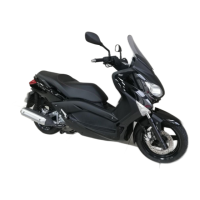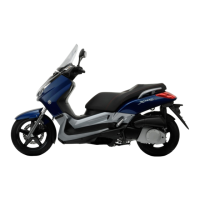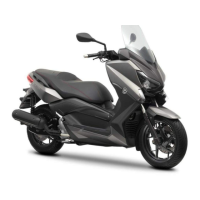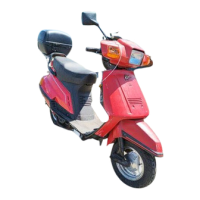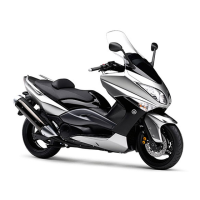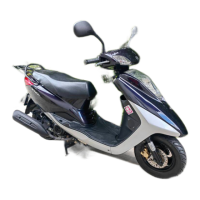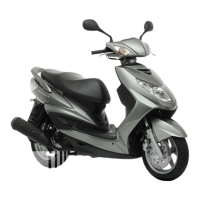Do you have a question about the Yamaha XMAX YP250RA and is the answer not in the manual?
Welcome message and explanation of the owner's manual's utility.
Explains symbols like WARNING, NOTICE, and TIP for important information.
Emphasizes owner's responsibility for safe operation and proper techniques.
Details essential protective gear and warns about carbon monoxide dangers.
Provides instructions for safely adding cargo and accessories to the scooter.
Advises on choosing genuine accessories and warns about aftermarket parts.
Offers tips on tire care, transporting, and general safe riding techniques.
Illustrates and labels components visible from the left side of the scooter.
Illustrates and labels components visible from the right side of the scooter.
Identifies and explains the various controls and instruments on the handlebars and dashboard.
Details the vehicle's anti-theft system and key management.
Explains the main switch functions and how to lock the steering.
Describes the 'LOCK' and 'P' (Parking) positions of the main switch.
Identifies and explains the meaning of dashboard indicator and warning lights.
Describes the features and displays of the vehicle's digital meter unit.
Details the functions of the fuel meter, clock, and odometer/tripmeter displays.
Explains display options like ambient temperature, fuel consumption, and speed.
Covers the self-diagnosis device and coolant temperature meter readings.
Explains the function of left and right handlebar controls for operation.
Details how to operate the front brake lever.
Explains rear brake lever operation and the Anti-lock Brake System (ABS).
Provides instructions on how to open and close the fuel tank cap.
Discusses recommended fuel, tank capacity, and refueling safety.
Explains the function and precautions related to the catalytic converters.
Details how to open, close, and secure the vehicle's seat.
Describes the front and rear storage compartments and their loading limits.
Guides on how to adjust the spring preload of the shock absorbers.
Explains the function and safety checks for the sidestand.
Describes the system that prevents starting under certain conditions.
Details pre-ride checks for fuel level, engine oil, and coolant.
Covers pre-ride checks for wheels, tires, brakes, and electrical systems.
Emphasizes understanding all controls to prevent accidents or injury.
Provides instructions and notices for safely starting the engine.
Guides on how to start moving and adjust speed using the throttle.
Explains proper braking methods and safety warnings for various conditions.
Offers tips for fuel efficiency and crucial engine break-in procedures.
Provides guidelines for parking the scooter safely, considering heat and fire hazards.
Explains how regular inspection and lubrication ensure safety and efficiency.
Introduces the owner's tool kit and the role of emission controls in vehicle performance.
Details the maintenance schedule for emission control components like fuel lines and spark plugs.
Covers checks and lubrication for brakes, wheels, tires, and steering bearings.
Outlines maintenance for engine oil, cooling system, final transmission oil, and V-belt.
Specifies checks for operation and adjustment of lights, signals, and switches.
Provides instructions for removing and installing body panels for maintenance access.
Guides on how to remove, inspect, and check the spark plug condition.
Details how to check the engine oil level and perform an oil change.
Explains how to check and change the final transmission oil.
Guides on checking coolant level and procedures for changing the coolant.
Describes replacement of the air filter element and cleaning of V-belt case air filter hoses.
Covers checking throttle grip play and valve clearance adjustment.
Details tire air pressure settings and pre-ride tire inspection procedures.
Specifies minimum tread depth and warnings about tire wear and replacement.
Discusses cast wheel checks and ensuring no free play in brake levers.
Explains how to check brake pad wear using indicator grooves.
Guides on checking the brake fluid level and precautions for insufficient fluid.
Covers inspection and lubrication of control cables for smooth operation.
Details lubrication for brake levers, centerstand, and sidestand pivots.
Guides on checking the condition and operation of the front fork and steering.
Explains how to check wheel bearings and battery connections.
Provides instructions on identifying and replacing blown fuses.
Covers replacing headlight bulbs and adjusting the headlight beam.
Addresses checking tail/brake lights and front turn signal lights.
Guides on how to replace a burnt-out rear turn signal light bulb.
Covers license plate bulb replacement and an introduction to troubleshooting.
Presents charts for diagnosing starting issues related to fuel, battery, ignition, and compression.
Provides a flowchart for diagnosing and addressing engine overheating issues.
Advises on cleaning and caring for matte finished parts to avoid damage.
Details methods for cleaning the scooter after normal use and in adverse weather.
Covers cleaning the windshield and ensuring brake safety after washing.
Provides instructions for storing the scooter for short and extended periods.
Lists vehicle dimensions, engine type, displacement, and oil specifications.
Details chassis type, tire specifications, brake system, and suspension details.
Outlines electrical system details, battery, lighting, and fuse specifications.
Explains how to locate and record vehicle identification and model label information.
Welcome message and explanation of the owner's manual's utility.
Explains symbols like WARNING, NOTICE, and TIP for important information.
Emphasizes owner's responsibility for safe operation and proper techniques.
Details essential protective gear and warns about carbon monoxide dangers.
Provides instructions for safely adding cargo and accessories to the scooter.
Advises on choosing genuine accessories and warns about aftermarket parts.
Offers tips on tire care, transporting, and general safe riding techniques.
Illustrates and labels components visible from the left side of the scooter.
Illustrates and labels components visible from the right side of the scooter.
Identifies and explains the various controls and instruments on the handlebars and dashboard.
Details the vehicle's anti-theft system and key management.
Explains the main switch functions and how to lock the steering.
Describes the 'LOCK' and 'P' (Parking) positions of the main switch.
Identifies and explains the meaning of dashboard indicator and warning lights.
Describes the features and displays of the vehicle's digital meter unit.
Details the functions of the fuel meter, clock, and odometer/tripmeter displays.
Explains display options like ambient temperature, fuel consumption, and speed.
Covers the self-diagnosis device and coolant temperature meter readings.
Explains the function of left and right handlebar controls for operation.
Details how to operate the front brake lever.
Explains rear brake lever operation and the Anti-lock Brake System (ABS).
Provides instructions on how to open and close the fuel tank cap.
Discusses recommended fuel, tank capacity, and refueling safety.
Explains the function and precautions related to the catalytic converters.
Details how to open, close, and secure the vehicle's seat.
Describes the front and rear storage compartments and their loading limits.
Guides on how to adjust the spring preload of the shock absorbers.
Explains the function and safety checks for the sidestand.
Describes the system that prevents starting under certain conditions.
Details pre-ride checks for fuel level, engine oil, and coolant.
Covers pre-ride checks for wheels, tires, brakes, and electrical systems.
Emphasizes understanding all controls to prevent accidents or injury.
Provides instructions and notices for safely starting the engine.
Guides on how to start moving and adjust speed using the throttle.
Explains proper braking methods and safety warnings for various conditions.
Offers tips for fuel efficiency and crucial engine break-in procedures.
Provides guidelines for parking the scooter safely, considering heat and fire hazards.
Explains how regular inspection and lubrication ensure safety and efficiency.
Introduces the owner's tool kit and the role of emission controls in vehicle performance.
Details the maintenance schedule for emission control components like fuel lines and spark plugs.
Covers checks and lubrication for brakes, wheels, tires, and steering bearings.
Outlines maintenance for engine oil, cooling system, final transmission oil, and V-belt.
Specifies checks for operation and adjustment of lights, signals, and switches.
Provides instructions for removing and installing body panels for maintenance access.
Guides on how to remove, inspect, and check the spark plug condition.
Details how to check the engine oil level and perform an oil change.
Explains how to check and change the final transmission oil.
Guides on checking coolant level and procedures for changing the coolant.
Describes replacement of the air filter element and cleaning of V-belt case air filter hoses.
Covers checking throttle grip play and valve clearance adjustment.
Details tire air pressure settings and pre-ride tire inspection procedures.
Specifies minimum tread depth and warnings about tire wear and replacement.
Discusses cast wheel checks and ensuring no free play in brake levers.
Explains how to check brake pad wear using indicator grooves.
Guides on checking the brake fluid level and precautions for insufficient fluid.
Covers inspection and lubrication of control cables for smooth operation.
Details lubrication for brake levers, centerstand, and sidestand pivots.
Guides on checking the condition and operation of the front fork and steering.
Explains how to check wheel bearings and battery connections.
Provides instructions on identifying and replacing blown fuses.
Covers replacing headlight bulbs and adjusting the headlight beam.
Addresses checking tail/brake lights and front turn signal lights.
Guides on how to replace a burnt-out rear turn signal light bulb.
Covers license plate bulb replacement and an introduction to troubleshooting.
Presents charts for diagnosing starting issues related to fuel, battery, ignition, and compression.
Provides a flowchart for diagnosing and addressing engine overheating issues.
Advises on cleaning and caring for matte finished parts to avoid damage.
Details methods for cleaning the scooter after normal use and in adverse weather.
Covers cleaning the windshield and ensuring brake safety after washing.
Provides instructions for storing the scooter for short and extended periods.
Lists vehicle dimensions, engine type, displacement, and oil specifications.
Details chassis type, tire specifications, brake system, and suspension details.
Outlines electrical system details, battery, lighting, and fuse specifications.
Explains how to locate and record vehicle identification and model label information.
| Engine Type | Liquid-cooled, 4-stroke, SOHC, 4-valve |
|---|---|
| Displacement | 249 cc |
| Compression Ratio | 10.5 : 1 |
| Fuel System | Fuel Injection |
| Ignition | TCI |
| Starter System | Electric |
| Front Suspension | Telescopic fork |
| Rear Suspension | Unit Swing |
| Front Tire | 120/70-15 |
| Rear Tire | 140/70-14 |
| Seat Height | 795 mm |
| Wheelbase | 1, 540 mm |
| Minimum Ground Clearance | 135 mm |
| Transmission | Automatic (V-belt) |
| Front Brake | Single disc, 267 mm |
| Rear Brake | Single disc, 245 mm |
| Fuel Capacity | 13.0 L |
| Weight | 179 kg |
